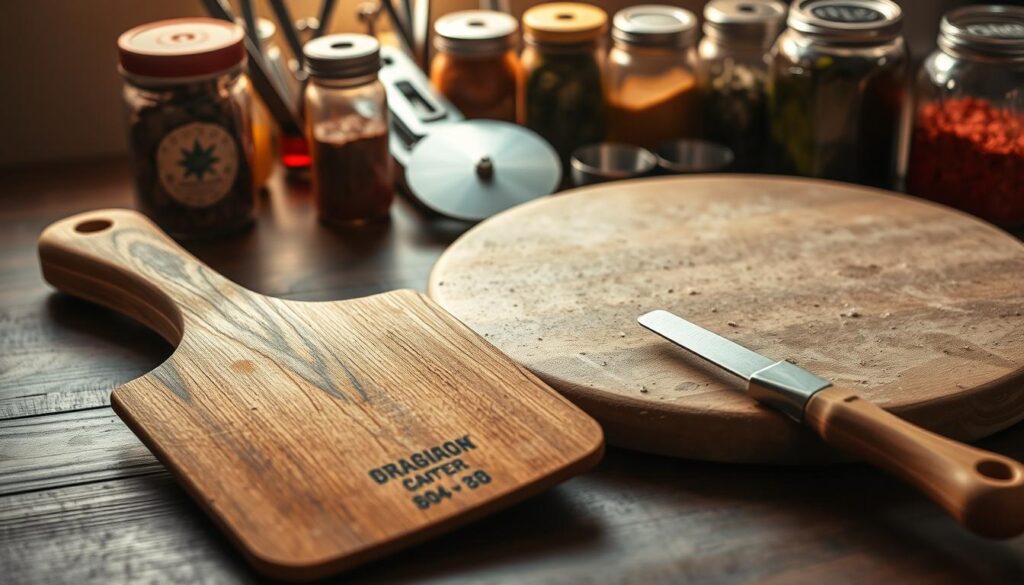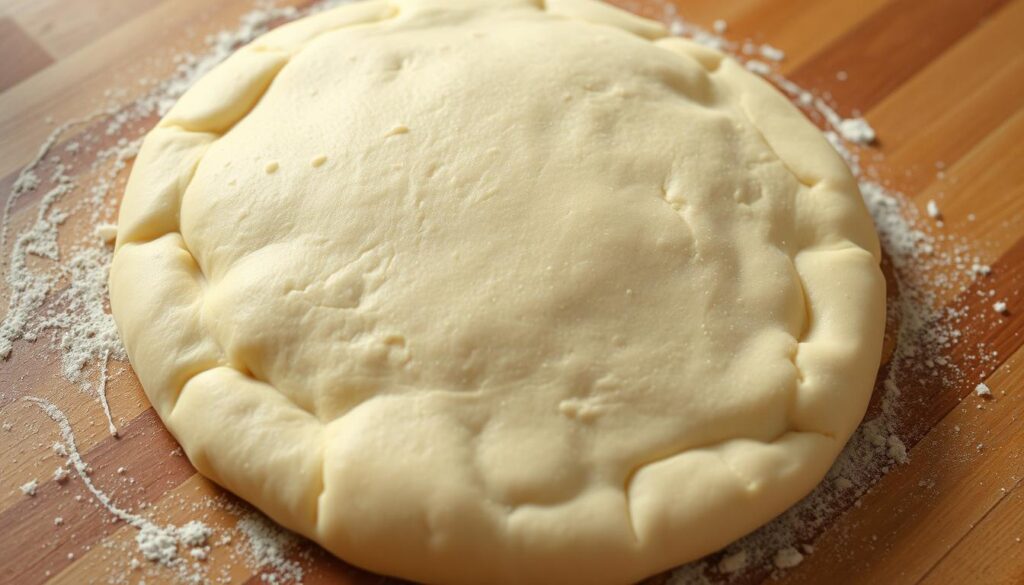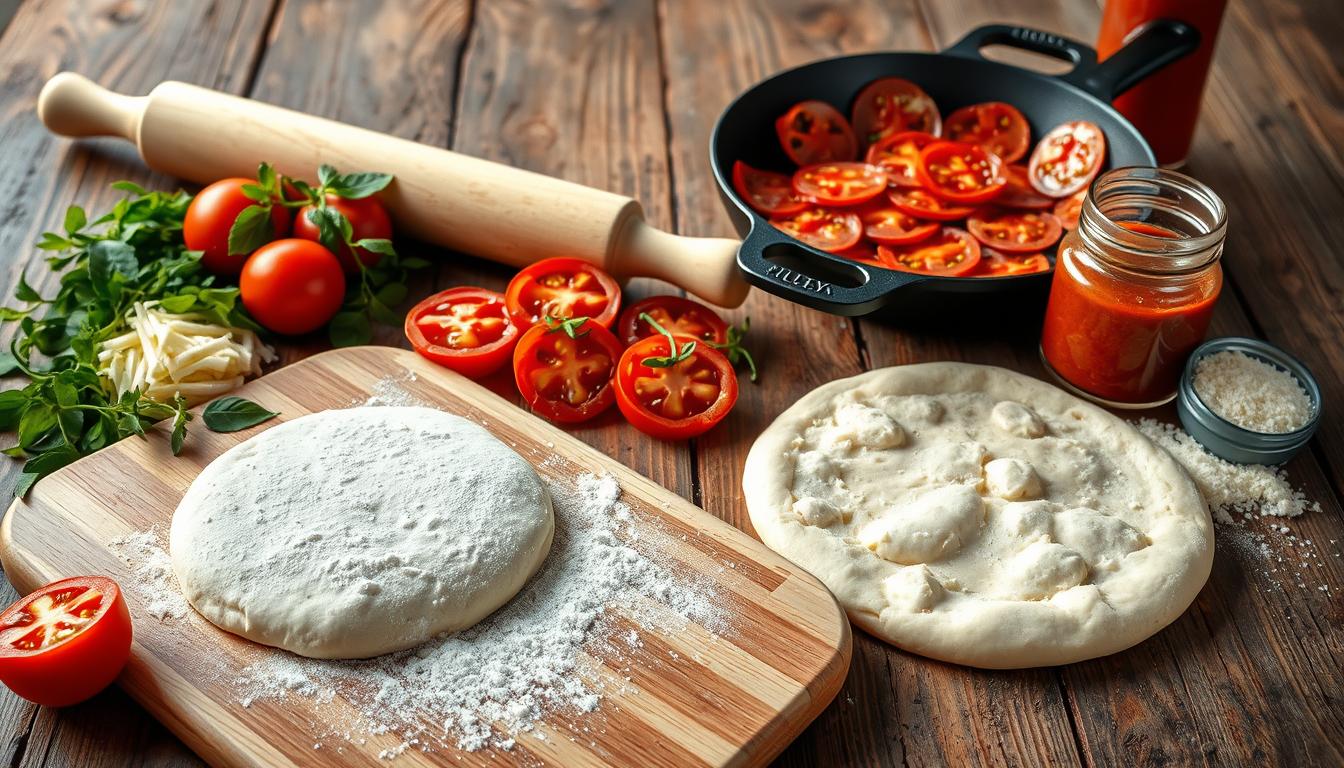Unleash the magic of homemade pizza in your kitchen! This guide unlocks secrets to crafting the best pizza, from crispy crusts to gourmet toppings. Whether you’re mastering pizza dough basics or experimenting with creative recipes, we’ll show you how to make every slice restaurant-worthy.
Discover how simple ingredients transform into mouthwatering creations. Our step-by-step advice covers everything from mixing pizza dough to pairing flavors, ensuring even beginners can bake confidence. Dive into styles like New York thin-crust or Chicago deep dish—all tailored for your home oven.
Key Takeaways
- Homemade pizza lets you control ingredients and flavors.
- Pizza recipes adapt to any dietary need or taste preference.
- Perfecting pizza dough is key to achieving professional-quality results.
- Gourmet pizza techniques are accessible with the right guidance.
- Explore global pizza styles without leaving your kitchen.
The Art of Homemade Pizza: Why Making It Yourself Matters
There’s something special about crafting a meal from start to finish. DIY pizza isn’t just about the end result—it’s a hands-on experience that brings creativity and joy into the kitchen. Every step, from kneading dough to sprinkling toppings, turns your kitchen into a space of discovery and shared fun.
The Satisfaction of Creating Your Own Masterpiece
Rolling out dough or inventing unique topping combinations lets you design a pizza that’s 100% you. Kids and adults alike love shaping their own mini pies, turning meal prep into a playful event. This process fosters teamwork and pride—like seeing your creation bubble golden in the oven.
Health Benefits of Homemade vs. Takeout Pizza
Switching to healthy pizza options starts with control. Compare store-bought pizza’s preservatives and excess oils to your own version: use whole-grain dough, fresh basil, or lean proteins. Studies show homemade versions cut sodium by up to 30%. For tips on ingredient swaps, check out this guide for smart substitutions.
Cost-Effective Cooking for Family Gatherings
Budget-friendly pizza nights save money. A family of four can enjoy a homemade feast for under $15—half the cost of delivery! Here’s why it adds up:
- No delivery fees or markups
- Stretch ingredients with bulk-bought staples like flour and canned tomatoes
- Leftovers freeze well for future meals
Family Pizza Night: More Than a Meal
Making pizza together strengthens bonds. It’s a chance to teach kids about cooking while laughing over messy dough. Turn it into a regular family pizza night tradition, where everyone votes on toppings or decorates crusts with herbs. These moments become memories, proving great food and time together are the best ingredients.
Essential Ingredients for the Perfect Pizza Base
Mastering the basics of pizza dough ingredients is key to crafting a base that’s crisp, airy, and full of flavor. Start by choosing the best flour for pizza based on your desired texture—high-protein bread flour for chewy Neapolitan crusts or all-purpose for everyday pies. Each type impacts rise, elasticity, and bite.
Flour Types and Their Impact on Texture
Experiment with these options:
- 00 flour: Italian imports like Caputo “00” create tender crumb and golden bubbles.
- Whole wheat: Adds nutty depth but requires extra hydration.
- All-purpose: A versatile pantry staple for casual dinners.
The Science Behind Yeast and Fermentation
Yeast activates the magic in any pizza dough recipe. Follow these pizza yeast tips:
- Proof yeast in warm (100–110°F) water before mixing.
- Cold-ferment dough overnight for deeper flavor development.
- Use instant yeast for faster activation compared to active dry.
“Fermentation is pizza’s slow dance—patience builds complexity.”
Water Temperature and Quality Considerations
Water isn’t just a mixer—it’s a catalyst. Use filtered water to avoid chlorine interference with yeast. Cold water slows fermentation, while warm (under 110°F) jumpstarts activation. For pizza crust secrets, remember: consistency matters. Track hydration levels precisely.
Salt, Sugar, and Oil: Finding the Right Balance
Salt strengthens gluten networks; add 1-1.5% by flour weight. A pinch of sugar feeds yeast without sweetness. Olive oil adds richness; use 2-3% for tenderness. Too much oil? Dough will resist rising—measure carefully.
For step-by-step guidance, explore proven pizza crust secrets from top chefs. Adjust these variables to turn your kitchen into a pizzeria’s rival!
Classic Neapolitan Pizza: Mastering the Original
Discover the soul of pizza with authentic Neapolitan pizza, a UNESCO-recognized masterpiece. Born in Naples, the margherita pizza symbolizes Italy’s culinary heritage with its vibrant colors: red tomatoes, white mozzarella, and green basil. To recreate this traditional pizza recipe at home, focus on simplicity and quality.
| Element | Traditional Detail | Home Adaptation |
|---|---|---|
| Flour | 00-grade Italian flour | Use “00” flour or blend all-purpose with cake flour |
| Tomatoes | San Marzano | Canned San Marzano imports |
| Baking | Wood-fired pizza oven (900°F) | Preheated baking steel for high-heat emulation |
Master Italian pizza techniques like hand-tossing dough for a thin, airy crust. The ideal bake achieves leopard-spot char marks using a quick, high-heat method. For margherita pizza, layer ingredients sparingly—topping excess crushes the tradition. Pro tip: Let dough ferment slowly (8–24 hours) for deep flavor.
- Use 00 flour for tender texture
- Stretch dough by hand, not rolling pin
- Bake at max oven temp (500°F+)
“A true Neapolitan pizza is 80% dough, 20% toppings.” — Naples Pizza Masters Association
Embrace the art of wood-fired pizza at home. With patience and precision, your kitchen can host a slice of Naples. Every bite celebrates centuries of tradition, proving perfection comes from purity of ingredients and technique.
American Pizza Styles: From New York to Chicago and Beyond
Explore the diverse American pizza styles across the U.S. Each region’s signature pie offers a taste of local history and innovation. For more pizza creativity, check out Delicious Pizza Recipes for inspiration. Let’s uncover how to recreate these iconic flavors at home.
New York-Style: The Art of the Fold
New York pizza’s legendary foldability starts with high-hydration dough and a blend of mozzarella. The secret? Water quality mimics NYC’s unique minerals. Use filtered water for better stretch. Fold it, eat it—no plate required.
Chicago Deep Dish: A Hearty Midwestern Tradition
Chicago deep dish flips the script: buttery crust lined with cornmeal, layered cheese, then sauce. Baked slowly, this thick-crust masterpiece needs 45-60 minutes. Add Italian sausage and pepperoni for a classic touch.
Detroit-Style: The Rising Star of Square Pizzas
Born in Detroit’s automotive factories, this square pizza bakes in blue steel pans. The crispy, cheese-caramelized edges are key. Use a 1-inch thick crust and melted mozzarella pooled beneath toppings.
California-Style: West Coast Innovation on a Crust
California pizza redefines tradition with bold toppings like barbecued chicken, fresh arugula, and goat cheese. Top with balsamic glaze or chili flakes for a modern twist. Experiment with local seasonal ingredients!
Creative Pizza Toppings That Will Transform Your Homemade Pies
Expand your pizza creativity beyond the ordinary with unique pizza toppings and gourmet pizza ideas. Whether experimenting with bold flavor mixes or seasonal ingredients, your next pizza can become a culinary adventure. Let’s dive into inspired pizza topping combinations that surprise and delight.
Sweet and Savory Combinations That Actually Work
Balance contrasts like honey and rosemary with prosciutto and figs, or mix tart apples with smoky bacon and caramelized onions. For a rich twist, try blue cheese paired with pears and walnuts. These pizza topping combinations turn tradition upside-down while keeping flavors in harmony.
International Flavors to Explore
| Region | Signature Toppings | Example Recipe |
|---|---|---|
| Mexican | Chorizo, cotija, pickled jalapeños | Grilled chorizo with avocado-lime crema and charred corn |
| Middle Eastern | Za’atar, labneh, caramelized onions | Labneh base with sumac-seasoned lamb and pomegranate molasses drizzle |
| Japanese | Teriyaki chicken, nori strips, pickled ginger | Teriyaki-glazed chicken with shredded nori and sesame seeds |
Seasonal Ingredient Suggestions for Year-Round Enjoyment
- Spring: Asparagus, peas, and fresh basil with lemon zest
- Summer: Heirloom tomatoes, grilled zucchini, and basil pesto
- Fall: Roasted butternut squash, caramelized onions, and sage
- Winter: Braised kale, potatoes, and sharp cheddar with garlic
Pair seasonal pizza ingredients with complementary cheeses and herbs to highlight peak flavors. Explore international pizza flavors and bold combinations to make every slice a discovery.
Pizza Equipment Worth Investing In: From Stones to Peels

Mastering homemade pizza starts with the right pizza making tools. A quality pizza stone or pizza steel ensures even baking, while a sturdy pizza peel prevents dough tears. Let’s break down essentials that turn your kitchen into a pizzeria. Pro tips from experts highlight how tools like a digital scale and dough dockers take consistency to the next level.
A pizza stone retains heat, creating that signature crispy crust. Opt for Emile Henry’s classic ceramic option for affordability. For superior conductivity, a Lodge pizza steel delivers faster preheating but adds weight. Cast iron pans work well for thick-crust styles, but nothing beats a pizza oven’s even heat distribution. Compact models like the Ooni Karu 12 let you mimic wood-fired results at home.
- Pizza Peel: Wooden peels glide smoothly, while metal ones are easier to clean. Look for wide edges to avoid crust crumpling.
- Scrapers & Dockers: Stainless steel scrapers clean work surfaces effortlessly. Use a dough docker to prevent air bubbles in thick dough.
- Storage Tools: Proofing baskets and cloths keep dough airy during rising phases.
Invest wisely—start with a stone or steel, then build your toolkit. A well-chosen pizza peel and oven can transform your homemade pies. Less is more: prioritize items that directly impact crust texture and cooking speed. Your kitchen deserves tools that last, so choose durable materials and read reviews before buying.
Vegetarian and Vegan Pizza Recipes That Don’t Compromise on Flavor
Exploring vegetarian pizza or vegan pizza doesn’t mean sacrificing taste. Modern recipes prove plant-based pizza can be just as craveable as traditional versions. Start with dairy-free pizza bases using cashew cheese or brands like Follow Your Heart, which melt smoothly. For veggie pizza toppings, pair roasted eggplant with balsamic glaze or marinate zucchini in garlic and herbs to boost flavor.
Plant-Based Cheese Alternatives That Actually Melt
- Nut-based cheeses: Cashew or almond blends create creamy textures. Brands like Miyoko’s offer aged varieties for sharpness.
- Tofu ricotta: Silken tofu mixed with lemon and herbs mimics traditional spreads.
- Nutritional yeast: Adds cheesy umami without dairy.
Vegetable Combinations for Maximum Flavor Impact
Roast bell peppers, mushrooms, and artichokes for depth. Try these combos:
- Indian-spiced potato pizza with turmeric and cumin.
- Korean-inspired kimchi and gochujang drizzle.
- Greek-style with artichokes, kalamata olives, and oregano.
Vegan Dough Variations
Swap honey in dough recipes with agave or barley malt. Experiment with whole-grain flours like spelt or chickpea for nutty tones. For extra rise, use instant yeast and let dough rest 12–24 hours.
“My family prefers our vegan pizza nights now—the caramelized onions and cashew mozzarella are game-changers!”
Whether for dietary needs or curiosity, these recipes show plant-based pizza can be a crowd-pleaser. Prioritize fresh produce and creative flavor pairings to elevate every slice.
Gluten-Free Pizza: Techniques and Recipes for Dietary Restrictions

Making celiac-friendly pizza that rivals traditional versions requires creativity and precision. Start by mastering the gluten-free flour blend—the foundation of any great crust. Experiment with blends combining rice flour, tapioca starch, and sorghum to balance texture and flavor. A mix of 60% brown rice flour, 20% tapioca starch, and 20% sorghum flour creates a sturdy base for a crispy gluten-free crust.
- Flour alternatives: Brown rice flour adds lightness, while potato starch boosts browning.
- Binding magic: Add ½ teaspoon xanthan gum per cup of flour for elasticity.
- Par-bake secret: Pre-bake the gluten-free pizza dough 8-10 minutes before adding toppings.
Binding agents like psyllium husk powder (¼ tsp per cup of flour) prevent crumbly textures. For gluten-free pizza recipes, follow this method:
- Mix dry ingredients thoroughly before adding liquids.
- Let dough rest 15 minutes to hydrate properly.
- Bake at 475°F (245°C) on a preheated stone for optimal crispiness.
Common issues? Here’s how to fix them:
Issue: Dough tears when stretching. Solution: Add extra water, then knead briefly.
Issue: Soggy bottom. Solution: Brush dough with olive oil before adding sauce.
For expert-level tips, explore fermentation techniques from professional pizzaiolos to enhance flavor depth. With practice, these gluten-free pizza dough methods deliver results even skeptics will crave.
Quick Weeknight Pizza Ideas When You’re Short on Time
Busy evenings don’t mean skipping homemade pizza. These quick pizza recipes turn weeknight cravings into family-friendly meals in under 30 minutes. Start by prepping essentials ahead: store-bought dough can be boosted with garlic or herbs while defrosting, and sauces blend in a snap with pantry staples. Frozen ingredients like pre-shredded cheese and jarred marinara save time without sacrificing taste.
Try these 30-minute pizza shortcuts: no-rise dough mixes use baking powder for instant rise, ready in 15 minutes. For easy homemade pizza, top store-bought dough with pre-cooked chicken, spinach, and mozzarella for a 20-minute meal. Sheet-pan pizzas bake everything together—toss veggies, sauce, and cheese on parchment for a hands-off approach.
- 5-Ingredient Margherita: Fresh basil, sliced tomatoes, and buffalo mozzarella on pre-made dough. Bake at 475°F for 10 minutes.
- Buffalo Chicken Pizza: Shredded rotisserie chicken mixed with ranch and hot sauce, topped with blue cheese and scallions.
- Breakfast Pizza: Cook eggs and crumbled sausage, spread on warm naan, add cheddar, and broil until bubbly.
| Time-Saving Tip | How It Works |
|---|---|
| Freeze portions of homemade sauce in ice cube trays | Use 2-3 cubes per pizza, thawed |
| Prep veggie toppings weekly | Chop mushrooms, bell peppers, and onions on Sunday |
| Use a pizza stone preheated in a 500°F oven | Cook faster with even heat distribution |
These weeknight dinner ideas prove easy homemade pizza is always an option. Stock your pantry with these essentials and watch dinner time shrink without sacrificing flavor.
Conclusion: Your Journey to Pizza Perfection Starts Now
Whether you’re a beginner or a seasoned cook, pizza making tips and homemade pizza techniques can turn any kitchen into a creative space. Start with simple recipes like Margherita or BBQ Chicken, then explore the pizza recipe collection at news2.pizzacream.com to discover new flavor combinations. Every attempt is a step toward building pizza expertise—don’t fear imperfections; even slightly burnt crusts or uneven toppings mean you’re learning.
Your pizza cooking journey isn’t about perfection but passion. Use fresh ingredients, experiment with toppings, and adjust dough ratios until you find your favorite style. Share your creations with family, track progress in a notebook, and celebrate small victories. From gluten-free crusts to spicy Buffalo cauliflower toppings, pizza’s adaptability makes it a lifelong culinary adventure.
Begin with basic techniques, then elevate your skills over time. Remember: the best pizzas are made by those who dare to try. Grab your flour, sauce, and imagination—the oven is waiting.
